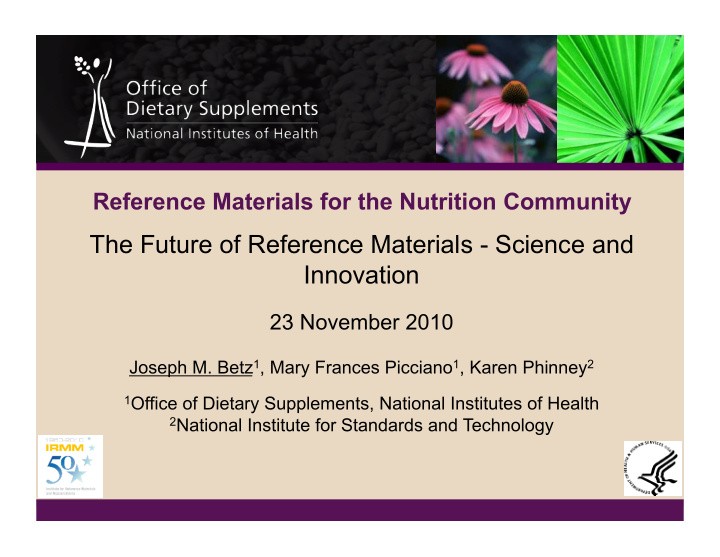



Reference Materials for the Nutrition Community The Future of Reference Materials - Science and Innovation 23 November 2010 Joseph M. Betz 1 , Mary Frances Picciano 1 , Karen Phinney 2 1 Office of Dietary Supplements, National Institutes of Health 2 National Institute for Standards and Technology
NIH is the Nation’s Medical Research Agency www.nih.gov OFFICE OF DIETARY SUPPLEMENTS 2
Reference Materials and ODS ODS Analytical Methods and Reference Materials Program- multi-year project with NIST • “Suites” of Standard Reference Materials – Supplement raw materials & finished products – Certified and Reference values for marker compounds, nutrients, contaminants • Calibration Standards www.nist.gov OFFICE OF DIETARY SUPPLEMENTS 3
Outcomes In Process Available • St. John’s wort • Botanical oils (tocopherols) • Soy • Fish oil (FAs, tocopherols) • Black cohosh • Ginkgo • Kudzu • Bi:er orange • Red clover • Saw palme:o • Turmeric • Mul?vitamin/mineral tablets • Pomegranate • Botanical & fish oils (Ω3’s, 6’s) • Ginsengs (Asian, Siberian) • Green tea • Berries • Vit. D in human serum OFFICE OF DIETARY SUPPLEMENTS 4
NIST SRM for Nutrition (available prior to ODS program) Foods with values assigned for nutrients (proximates, vitamins, carotenoids, elements, fa:y acids, amino acids as appropriate) • SRM 1849 Infant/Adult Nutri?onal Formula • SRM 1946 Lake Superior Fish Tissue • SRM 2384 Baking Chocolate • SRM 2385 Slurried Spinach • SRM 2387 Peanut Bu:er • SRM 3287 Blueberry (Fruit) plus 5 more in progress OFFICE OF DIETARY SUPPLEMENTS 5
NIST SRM for Nutrition • 909c‐Glucose, urea, uric acid, cholesterol, crea?nine, total protein, electrolytes • 968e‐Fat‐Soluble Vitamins, Carotenoids, Cholesterol, tocopherols, re?nol, beta‐carotene • 2670‐Toxic Elements in Urine: 14 elements • 3950‐Vitamin B 6 in Human Serum • 3951‐Vitamin B 12 in Human Serum OFFICE OF DIETARY SUPPLEMENTS 6
Case Study: OFFICE OF DIETARY SUPPLEMENTS 7
Vitamin D Status of the US Population? OFFICE OF DIETARY SUPPLEMENTS 8
25(OH)D Assay Concerns (Looker et al., 2008) • 1988-94 vs. 2000 - 2004: − Reformulation (introduction of antibody to improve binding) of RIA assay kit shifts in assay results between these two time periods − Adjusted for assay drifts to compare time trends in 25(OH)D and identify contributing factors Looker et al. Am J Clin Nutr 2008;88:1519‐27. OFFICE OF DIETARY SUPPLEMENTS 9
Adjustment Affects Policy Conclusions • Adjustments for assay differences: − Looker et al. (2008): • Overall mean 25(OH)D lower in 2000-2004 than in 1988-94 • Assay changes accounted for much of the difference • No adjustment for assay differences: − Ginde et al. (2009) : • Marked decrease in 25(OH)D in 2000-2004 from 1988-1994 • Growing epidemic of vitamin D insufficiency − Saintonge (2009): • Vitamin D deficiency is increasing from 1988-1994 to 2006 • National fortification and public health strategy OFFICE OF DIETARY SUPPLEMENTS 10
NIST SRM- July 2009 • SRM 972‐ Vitamin D metabolites in Human Serum − Suite of four 1.0 ml vials with cer?fied and reference values for 25(OH)D 2 , 25(OH)D 3 , and 3‐epi‐25(OH)D 3 • SRM 2972‐ 25(OH)D 2 & 25(OH)D 3 Calibra?on Solu?ons − SRM 2972 is a set of ethanolic calibra?on solu?ons and has cer?fied values for 25(OH)D 2 and 25(OH)D 3 • Value assignment by isotope‐dilu?on LC‐MS and LC‐MS/MS • RM drives science‐ previously thought 3‐epi only occurred in infants OFFICE OF DIETARY SUPPLEMENTS 11
• Ques%ons about equivalence of LC/MS assay response to 25(OH)D 2 and 25(OH)D 3 − Immunoassays measure “total” 25(OH)D − Older LC/MS methods did not resolve 3‐epimer • 3‐epimers of 25(OH)D may bias MS‐based methods 25(OH)D 3 3‐epi‐25(OH)D 3 OFFICE OF DIETARY SUPPLEMENTS 12
NIST LC-MS Methodology for 25(OH)D 25(OH)D 2 25(OH)D 3 3‐epi‐25(OH)D 3 25(OH)D 2 ‐[ 2 H 3 ] 25(OH)D 3 ‐[ 2 H 6 ] Tai et al. (2010) Anal Chem 82:1942‐1948 OFFICE OF DIETARY SUPPLEMENTS 13
Level 1 65 ± 15 nmol/L 25‐hydroxyvitamin D 3 (“normal”) Level 2 Blend of “normal” serum and horse serum to obtain approximately half the level of 25‐hydroxyvitamin D 3 in the “normal” pool (35 ± 5 nmol/L) Level 3 “Normal” serum spiked with equivalent amount of 25‐ hydroxyvitamin D 2 Level 4 “Normal” serum spiked with 3‐epi‐25‐hydroxyvitamin D 3 OFFICE OF DIETARY SUPPLEMENTS 14
Commutability is defined as the equivalence of the mathemaZcal relaZonships between the results of different measurement procedures for a reference material and for representaZve samples from healthy and diseased individuals. Vesper et al., Clin. Biochem. Rev., 28 (2007) 139 Reasons a reference material may not be commutable: • Material handling, processing (lyophiliza?on, filtering, etc.) • Supplementa?on with na?ve or non‐na?ve analytes • Differences between samples from healthy and diseased individuals OFFICE OF DIETARY SUPPLEMENTS 15
Other RM needs Marketed products‐matrices • Delayed release dosage forms‐ ion exchange resins, etc. • Oil‐filled gelcaps‐ vegetarian and animal gela?n • Microencapsulated materials‐ Carrageenan, gela?n, etc. • “Nano” ingredients in finished products • “Unusual” matrix source for nutrients and nutrient elements‐ e.g. iodine in kelp vs KI OFFICE OF DIETARY SUPPLEMENTS 16
Other RM needs Clinical materials and calibra?on standards • Folate, other complex vitamers in serum for LC/MS • Biomarkers of nutrient exposure vs. markers of Nutrient status‐ e.g. Omega‐3 fa:y acids in serum vs. red blood cell membrane • Isotope labeled nutrients and metabolites as calibra?on standards for MS detec?on • Serum based calibra?on solu?ons Yetley et al. (2010) J Nutr 140: 2030S‐2045S OFFICE OF DIETARY SUPPLEMENTS 17
Non-RM Activities NIST Vitamin D metabolite Laboratory Quality Assurance Program & Dietary Supplement Laboratory Quality Assurance Program • NIST sends blinded material, practice sample – Participants perform analyses and return data to NIST – NIST provides feedback on blinded results, including suggestions for method optimization • To participate (no cost), send e-mail to vitdqap@nist.gov or DSQAP@nist.gov OFFICE OF DIETARY SUPPLEMENTS 18
“Reference Materials are the most efficient means to transfer accuracy to a field” -John Eckfeldt, MD, Ph.D. Professor of Laboratory Medicine, University of Minnesota Medical Center OFFICE OF DIETARY SUPPLEMENTS 19
Joseph M. Betz www.ods.od.nih.gov E-mail: ods@nih.gov E-mail: betzj@mail.nih.gov http://dietary-supplements.info.nih.gov/FactSheets/AMRMProgramWebsite.asp OFFICE OF DIETARY SUPPLEMENTS 20
Recommend
More recommend